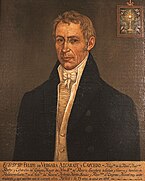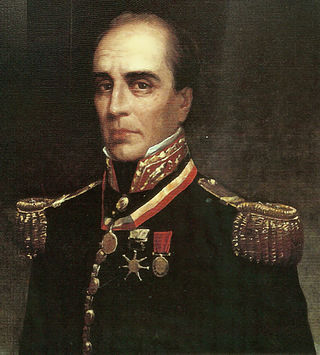
Rafael José Urdaneta y Farías was a Venezuelan General and hero of the Spanish American wars of independence. He served as President of Gran Colombia from 1830 until 1831. He was an ardent supporter of Simón Bolívar and one of his most trusted and loyal allies.
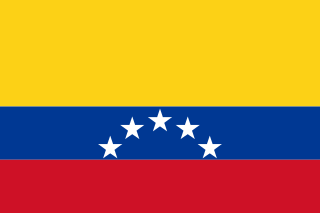
The Republic of Spanish Haiti, also called the Independent State of Spanish Haiti was the independent state that succeeded the Captaincy General of Santo Domingo after independence was declared on 30 November 1821 by José Núñez de Cáceres. The republic lasted only from 1 December 1821 to 9 February 1822 when it was invaded by the Republic of Haiti.

Policarpa Salavarrieta Ríos, also known by her nickname of La Pola, was a Neogranadine seamstress who spied for the Revolutionary Forces during the Spanish Reconquista of the Viceroyalty of New Granada. She was captured by Spanish Royalists and ultimately executed for high treason. The Day of the Colombian Woman is commemorated on the anniversary of her death. She is now considered a heroine of the independence of Colombia.

The vice president of Colombia is the second-highest officer in the executive branch of the national government, after the president of Colombia, and ranks first in the presidential line of succession. The vice president is indirectly elected together with the president to a four-year term of office by the people of Colombia through the Popular Vote. Since the passage of the Article 102 Amendment to the Colombian Constitution, the vice president may also be appointed by the president to fill a vacancy, upon leave of absence or death, resignation, or removal of the president. Since the 1990s, the vice president has been afforded an official residence at the Vice Presidential House of Bogotá, D.C.
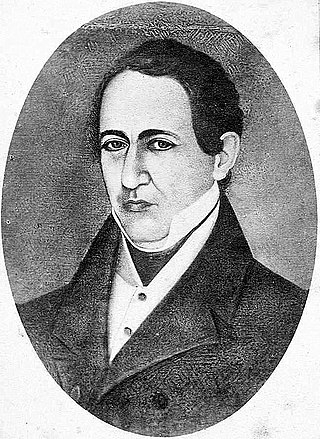
Domingo de Caycedo y Sanz de Santamaría was a Colombian statesman who served as the vice president of Gran Colombia and the Republic of New Granada. He served as acting President of Colombia a total of eleven times, the most terms any president has served to date. He is also credited for creating the Republic of New Granada after the division of Venezuela and Ecuador.

Pedro Alcántara Herrán Martínez de Zaldúa was a Colombian general and statesman who served as President of the Republic of the New Granada between 1841 and 1845. As a general he served in the wars of independence of the New Granada and of Peru.

José María Dionisio Melo y Ortiz was a Colombian general and political figure who fought in the South American wars of independence, and who rose to power and briefly held the presidency of Colombia in 1854. Of Pijao ancestry, he is considered the country's first and only indigenous president.

José María Ramón Obando del Campo was a Neogranadine General and politician who twice served as President of Colombia. As a General, he initially fought for the Royalist Army during the Independence Wars of Colombia, ultimately joining the revolutionary forces of Simón Bolívar towards the end, but once independence was attained he opposed Bolívar's Centralist government.

Colombian literature, as an expression of the culture of Colombia, is heterogeneous due to the coexistence of Spanish, African and Native American heritages in an extremely diverse geography. Five distinct historical and cultural traditions can be identified, with their own socioeconomic history: the Caribbean coast, Greater Antioquia, the Cundinamarca-Boyacá Highlands, Greater Tolima and the Western Valley. Colombia produced one of the richest literatures of Latin America, as much for its abundance as for its variety and innovation during the 19th and 20th centuries. Colombian intellectuals who forged the literature of this period also contributed decisively to the consolidation of Latin American literature.

Dilian Francisca Toro Torres is a Colombian physician and politician, she served as Senator of Colombia from 2002 to 2013. She was investigated by the Supreme Court of Justice of Colombia on charges of money laundering, and remained under preventive detention from 25 July 2012 to 1 August 2013 at the Police Centre for Higher Studies (Cespo) in Bogotá. She currently serves as Governor of Valle del Cauca Department.
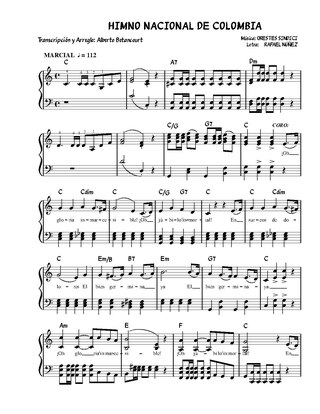
The National Anthem of the Republic of Colombia is the official name of the national anthem of Colombia. It was originally written as a poem in 1850 by future President Rafael Núñez as an ode to celebrate the independence of Cartagena. The music was composed by Italian-born opera musician Oreste Síndici, at the request of Bogotan actor José Domingo Torres, during the presidency of Núñez, and with lyrics refined by Núñez himself, it was presented to the public for the first time on 11 November 1887. The song became very popular and was quickly adopted, albeit spontaneously, as the national anthem of Colombia.

Rodrigo Hernán Lloreda Caicedo was a Colombian lawyer and politician who was appointed to several senior positions under different presidents, with both domestic and foreign affairs responsibilities, beginning in 1968 as appointed governor of his department and briefly as ambassador to the United States. In his last post, Lloreda was the 17th Minister of National Defence, serving under President Andrés Pastrana Arango from 1998 to 1999.

The Vergara family is one of the most aristocratic families of Colombia and Chile with origins in Bergara, Spain. The House of Vergara had its period of greatest influence between the 17th, 18th, and 19th centuries. The family is spread across several branches in Spain, Colombia, Chile and the US. The Vergara family is considered as one of the first families of Spaniards in the Americas that arrived first as conquistadors, then as royal officers of the Spanish crown. The Vergara Family have produced four presidents of Colombia by the same surname; and three more related by blood. Another branch is considered amongst the founding families of Chile. Originally from Gipuzkoa, Spain, more specifically from Bergara, a municipality in Basque Country.
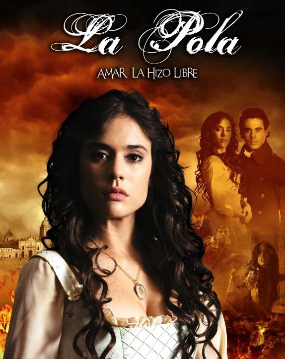
La Pola is a Colombian drama telenovela based on historical facts and directed by Sergio Cabrera for RCN Televisión. The series tells the political and loving life of Policarpa Salavarrieta Ríos,a woman who became one of the most important figures in the history of the Independence of Colombia for preferring death instead of submission. The series originally aired from September 13, 2010, to July 27, 2011.

Linda Lizeth Caicedo Alegría is a Colombian professional footballer who plays as a forward for Liga F club Real Madrid and the Colombia women's national team.

Luis de Ayala y Vergara was a criollo lawyer, politician from the capital of the Viceroyalty of the New Granada. During the South American independence he exercised the executive power as State Councilor of the Free and Independent State of Cundinamarca in 1812, due to the absence of President Antonio Nariño. Ayala y Vergara is considered one of the first heads of state of the young Colombia.
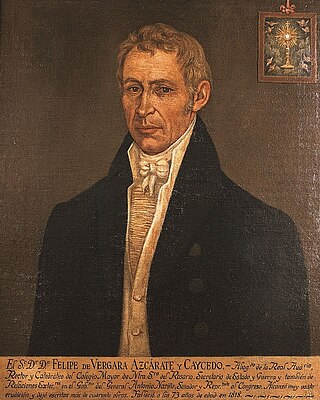
Felipe de Vergara Azcárate y Caycedo was a Colombian lawyer, professor, rector, Senator and Congressional Representative who held the presidency of Colombia from November 26, 1812, to December 14, 1812, also Lieutenant Governor of Cartagena de Indias and Prosecutor of the same, Royal Accountant of the treasury of Panamá, served as Secretary of State, War and Foreign Relations. He was principal member of the Government Junta appointed by General Antonio Nariño to govern Cundinamarca in his absence. Felipe was considered one of the best patriots who have distinguished themselves in all their vows and personal services.

The first family of Colombia is the family of the president of Colombia, who is both head of state and head of government of Colombia. It is an unofficial title for the family of a republic's head of state. Members of the first family consist of the president, the First Lady of Colombia, and any of their children. However, other close relatives of the president and first spouse, such as parents, grandchildren, stepchildren, and in-laws, may be classified as members of the first family for context purposes. The first family of Colombia live in the presidential residence Casa de Nariño in Bogotá, Colombia.
Colombina, or Dulces Colombina, is a Colombian multinational candy brand. The brand operates in Venezuela, the United States and 78 other countries around the world.

Carlos Arango Vélez, was a Colombian Jurist and Liberal Party Politician.

